Drake Graham, a contemporary music legend and influential figure, once quoted, “Reviews condition people. At the end of the day, a lot of human minds are malleable. They can be easily shaped with strong words.”
The people who toil for your company also need feedback and suggestions from time to time. This ensures that neither the company nor their experience letters takes the toll.
Additionally, as a boss, when you offer genuine feedback to your employees, it really shows that you care about their growth as a performer and human being.
Therefore, whether your employees are freshers or experienced staff members, an impartial assessment must be encouraged within organizations. A daily employee review isn’t feasible because it hinders operations and supports the evil roots of micro-management. This is why as an empathetic leader, you must conduct it annually.
Sometimes, it’s a moment’s pressure, other times, both employees and the company undergo tough times. Assessment during these shorter frames will not highlight the true picture. An annual employee review will bring in picture a broader period where employees would have had the chance of developing and improving on their own. Thus, better performance reports will be generated. Moreover, it is this assessment that will determine salary raises and promotions within the organization.
In this blog we have put together our expert-designed annual employee review templates. Avail a content-ready framework about what parameters should be used in your annual employee review. Evaluate competencies, and generate reports with our annual employee review templates and forms. Let’s check out these 100% editable designs ready for download and use now!
Annual Employee Review Templates for You
Template 1: Annual Performance Review PowerPoint Presentation
Download this annual performance review template to compile a rulebook governing the feedback process. Enlist all parameters relevant to your setup based on which you want to rate your employees in this PPT Playbook. Specify the process of conducting reviews, and define dashboards to compare and present the assessment as shown in this PPT Guide. Your organization can employ this editable PPT Layout to guide future review sessions and know when to do it. To download this practical PowerPoint Design, click on the link given below.
Template 2: Employee Competency Annual Performance Review Template
Use this report card template to evaluate the competencies of your employees. With this content-ready PPT Layout, managers can assess their team members on their reliability, teamwork and civility. Rate your employees as to whether they are able to meet expectations or not as ME and DME (do not meet expectations) as shown. Add as many parameters of comparison as you like as this PT Slide is 100% editable. Download now!
Template 3: Annual Employee Performance Evaluation Review
Customize annual performance reports for your employees with this content-ready PPT Design. Associate each employee with their department, employee code, name, and review period as shown. Then evaluate their performance based on goals achieved, improvements shown, and core values demonstrated on a scale of 1-100. You can be a little meticulous and add details under each parameter defined above as shown in this employee review template. So without any delay, download it now!
Template 4: One-Page Employee Review Form Presentation Report
If you're looking for a concise one-page document to prepare and present employee reviews, look no further than this employee review form. This is an all-in-one performance report to create customized assessment for your employees. Evaluate their performance and represent the same with vivid infographic and supporting comments. You can also offer constructive feedback by pointing out areas of improvement and anticipate future goals in the limelight of this evaluation. Without further ado, take advantage of this performance evaluation template now!
Template 5: Employee Semi-Annual Review Sheet with Ratings
Conduct semi-annual reviews of your employees with this single slide PPT Layout. Use different parameters like technicality, professionalism and know-how to rate employee performance as unacceptable, needs improvement, meets expectations, exceeds expectations, or outstanding. You can support your assessment with additional comments to help employees comprehend their evaluation more. Click on the link below to get it now!
Template 6: Annual Employee Performance Review Template
Here is another ready-made design to share annual employee performance reviews of your team members. Customize individual reports for your team members as you evaluate their performance and relevant parameters. Rate them between excellent to poor and provide supporting comments for better comprehension. Download now!
Template 7: Annual Sales Performance Review of an Employee Template
Looking for a sales specific performance review template to evaluate your employees? Use this content-ready PowerPoint Slide to perform this assessment as you assess the efficiency of your salesforce. Track aspects like target achievements, improvements, and customer management skills demonstrated in their annual performance. Download now to create impactful progress reports.
Template 8: 360 Degree Annual Employee Performance Appraisal Form
Create an all-encompassing performance review of your employees with this PPT Design. Within this report, present your assessment on employee’s overall performance, goals achieved, improvements showcased, and core values depicted. Rate each of these skills on a scale of 1-100. Download this editable employee performance review tempate now to demonstrate a 360 degree evaluation of your team players.
Demonstrate a broad minded approach while rating employees and direct it toward their betterment and that of the company’s greater good. Download our dedicated annual employee review templates now!
PS: Employee review follows their wellness. Ensure your company takes the first step in having defined employee wellness programs in place by defining a rulebook with our best-in-class PPT Templates presented in this guide. Get’em now!
FAQs on Annual Employee Review
What is an annual employee review?
An annual employee review, also known as a performance review or appraisal, is a formal evaluation process conducted by employers to assess an employee's job performance and provide feedback. It typically takes place once a year, although some organizations may have more frequent review cycles.
During an annual employee review, the employee's supervisor or manager evaluates various aspects of the employee's work, including their job performance, skills, accomplishments, strengths, and areas for improvement. The purpose of the review is to gauge the employee's contributions to the organization, provide constructive feedback, set goals for the upcoming year, and make decisions regarding compensation, promotions, or other career-related matters.
Annual employee reviews aim to improve communication between employees and their supervisors, provide clarity on expectations, recognize achievements, identify areas for growth, and align individual performance with organizational goals. They serve as a tool for performance management and can help drive employee engagement, productivity, and professional development.
How do you write an annual employee review?
Writing an annual employee review requires careful thought and consideration to ensure that it accurately reflects the employee's performance, provides constructive feedback, and sets clear goals for the future. Here is a step-by-step guide on how to write an effective annual employee review:
- Review the employee's job description and performance goals: Familiarize yourself with the employee's job responsibilities and the goals they were expected to achieve during the review period.
- Gather feedback and data: Collect information on the employee's performance from various sources, such as self-evaluations, peer feedback, customer feedback, and any performance metrics or records available.
- Start with positive feedback: Begin the review by acknowledging the employee's strengths, achievements, and positive contributions.
- Address areas for improvement: Provide constructive feedback on areas where the employee can enhance their performance. Focus on behaviors or skills that can be developed rather than personal traits.
- Use the "sandwich" approach: Begin with positive feedback, then address areas for improvement, and end with encouraging and motivating comments. This helps balance the feedback and maintains a supportive tone.
- Be specific and provide examples:. Refer to specific projects, tasks, or incidents where the employee demonstrated particular strengths or areas for improvement.
- Set SMART goals: Ensure that the goals align with the employee's role, the organization's objectives, and their areas for improvement.
- Offer support and resources: If the employee needs support or additional resources to achieve their goals, provide guidance and suggest relevant training programs, workshops, or mentorship opportunities.
- Summarize and provide a closing statement: Recap the key points discussed in the review, emphasizing the employee's strengths, areas for improvement, and agreed-upon goals. Offer a closing statement that expresses confidence in the employee's potential and commitment to their growth.
- Seek input and finalize the review: Consider incorporating their perspective and making revisions as necessary. Once finalized, share the review with the employee and schedule a follow-up discussion to discuss it in person.
What are the techniques of performance review?
There are several techniques that can be used during a performance review to ensure a thorough and effective evaluation of an employee's performance. Here are some commonly used techniques:
- Self-evaluation: They can reflect on their accomplishments, challenges faced, and areas for improvement. This technique encourages self-awareness and promotes employee engagement in the evaluation process.
- 360-degree feedback: This technique involves gathering feedback from multiple sources, such as peers, subordinates, customers, and supervisors to uncover strengths and weaknesses that may not be apparent from a single evaluator.
- Behavior-based assessment: Instead of relying solely on subjective impressions, behavior-based assessments focus on specific observable behaviors and actions.
- Goal-based assessment: The review examines the extent to which the employee achieved their goals, the quality of their work, and the impact of their contributions.
- Critical incidents: The evaluator provides feedback on how the employee handled specific situations and identifies areas for improvement or areas of strength based on those incidents.
- Ranking or rating scales: This technique assigns numerical ratings or ranks to different aspects of performance, enabling easy comparison across employees.
- Narrative or descriptive feedback: Evaluators can provide detailed feedback on the employee's strengths, areas for improvement, and examples of their performance.
- Calibration sessions: This technique ensures consistency and fairness in evaluations by addressing potential biases and discrepancies in ratings. Calibration sessions promote objectivity and help maintain consistency across evaluations.
- Ongoing feedback and coaching: Regular check-ins and conversations between supervisors and employees help address performance issues promptly, provide guidance, and reinforce positive behavior.
How do you structure an employee review?
Structuring an employee review is essential to ensure a systematic and organized evaluation process. Here is a recommended structure that can be followed:
Introduction:
- Begin the review by expressing appreciation for the employee's contributions and their commitment to their role.
- State the purpose of the review, which is to provide feedback on their performance, discuss strengths and areas for improvement, and set goals for the future.
Review of Performance:
- Start with a summary of the employee's key responsibilities and goals.
- Evaluate their performance against those responsibilities and goals, providing specific examples to support your assessment.
- Assess their overall job performance, considering both quantitative data (e.g., results achieved) and qualitative factors (e.g., communication, teamwork).
- Highlight areas where the employee has excelled and acknowledge their achievements.
Areas for Improvement:
- Identify specific areas where the employee can improve their performance. Be constructive and provide clear examples or incidents that illustrate the need for improvement.
- Discuss any challenges or obstacles faced by the employee and explore strategies to overcome them.
- Offer guidance and support to help the employee address these areas for improvement effectively.
Strengths and Positive Contributions:
- Recognize and appreciate the employee's strengths, skills, and positive qualities.
- Discuss specific instances where the employee's strengths have had a positive impact on their work or the organization.
- Emphasize how these strengths can be further leveraged and developed.
Goal Setting:
- Collaborate with the employee to set specific, measurable, achievable, relevant, and time-bound (SMART) goals for the upcoming period.
- Align the goals with the employee's role, career aspirations, and the organization's objectives.
- Clearly define the expectations and criteria for success in achieving these goals.
- Discuss any additional training, resources, or support required to accomplish the goals.
Development and Training Opportunities:
- Identify potential areas for the employee's professional growth and development.
- Discuss relevant training programs, workshops, or mentorship opportunities that can enhance their skills or address their development needs.
- Encourage the employee to take ownership of their development and suggest ways they can actively pursue learning opportunities.
Closing:
- Summarize the key points discussed during the review.
- Reinforce your belief in the employee's potential and express confidence in their ability to succeed.
- Express your appreciation for their hard work and commitment.
- Provide an opportunity for the employee to ask questions or share their thoughts.
Remember, maintaining a positive and constructive tone throughout the review is crucial.


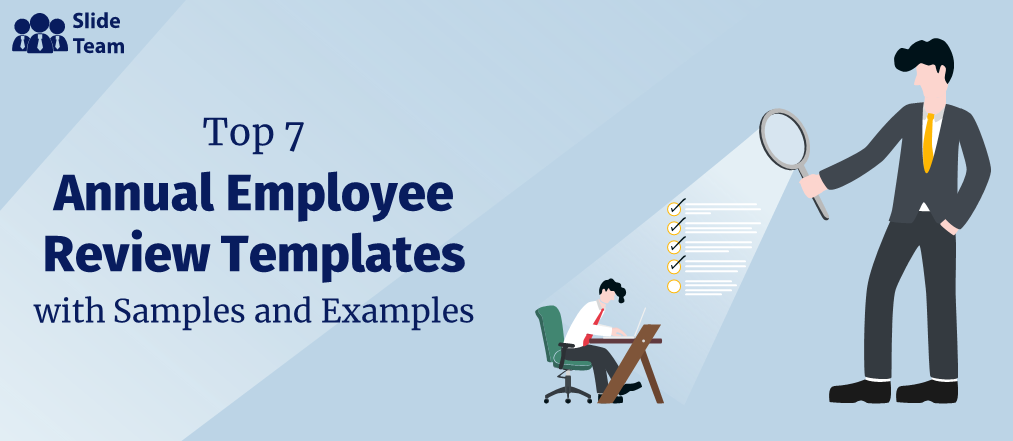


 Customer Reviews
Customer Reviews


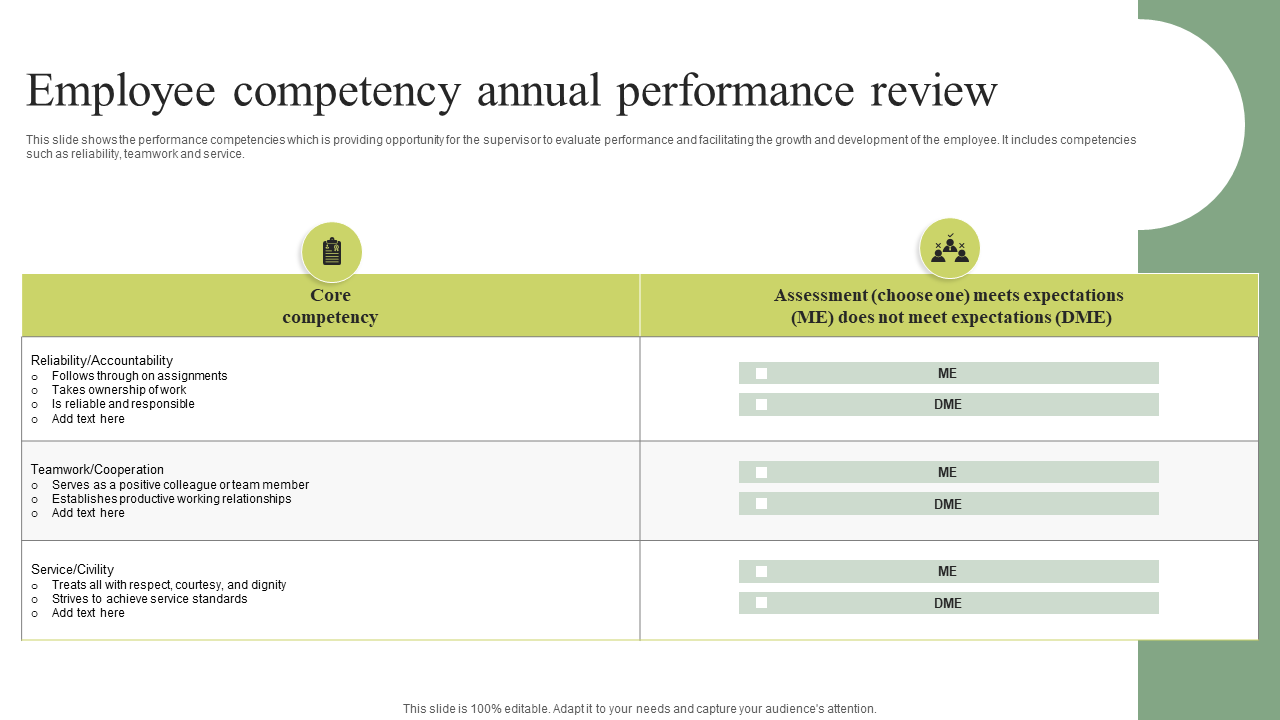

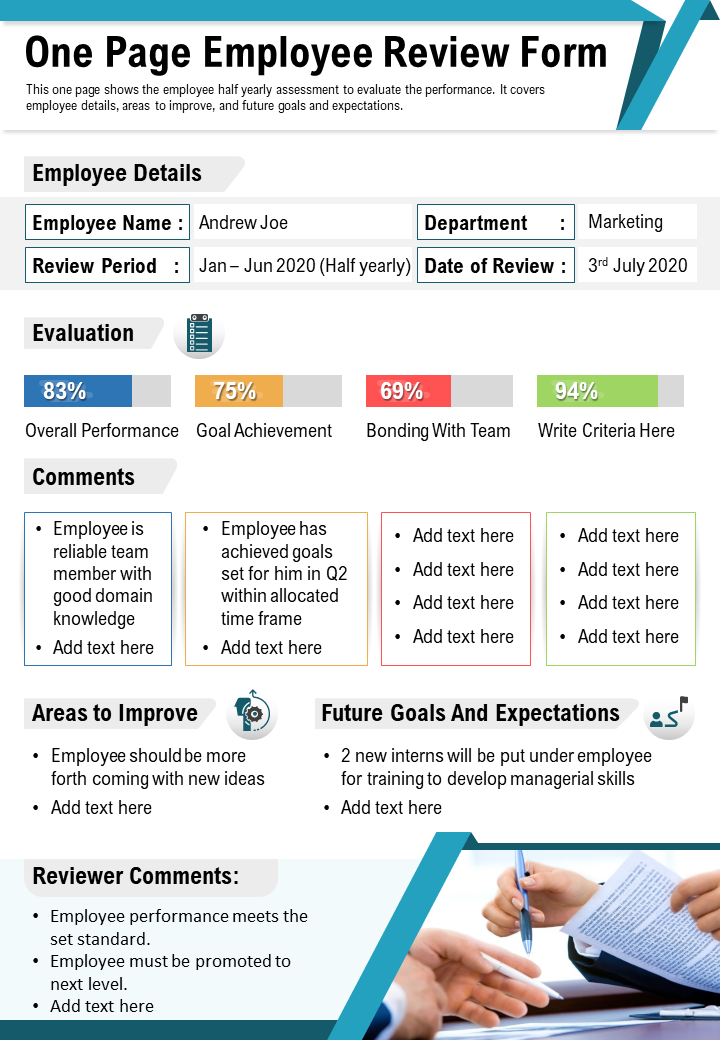
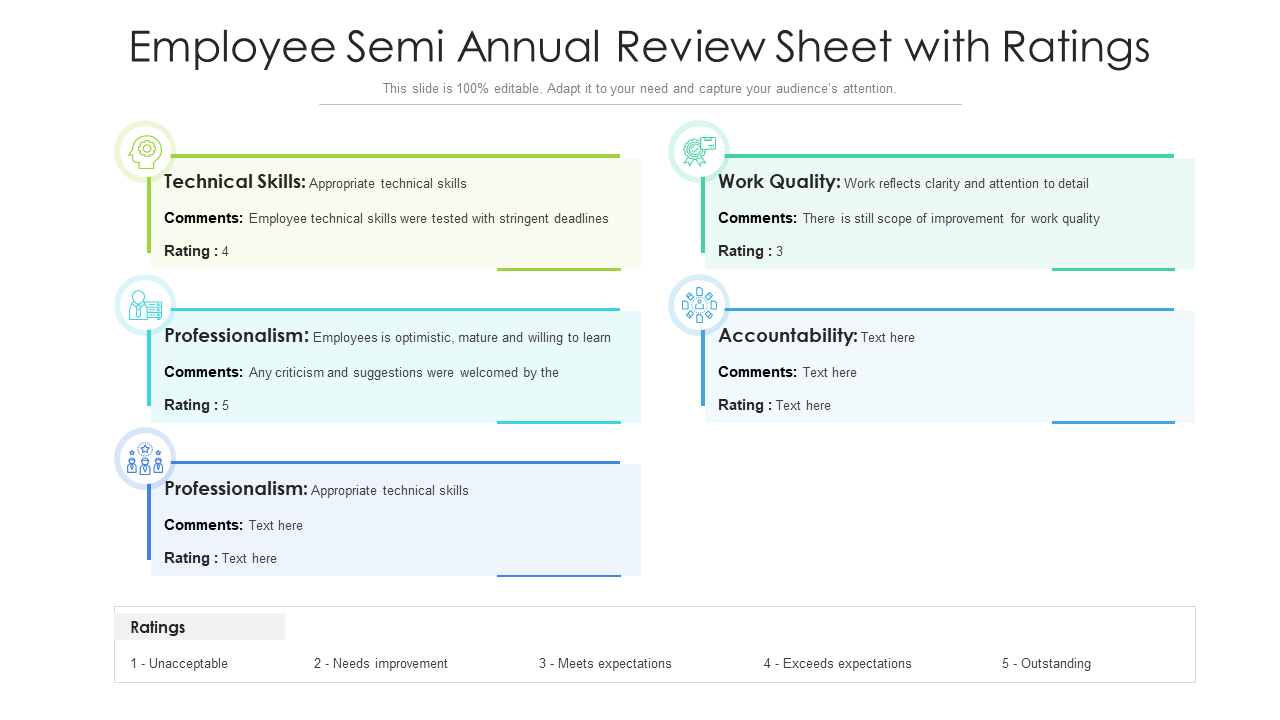
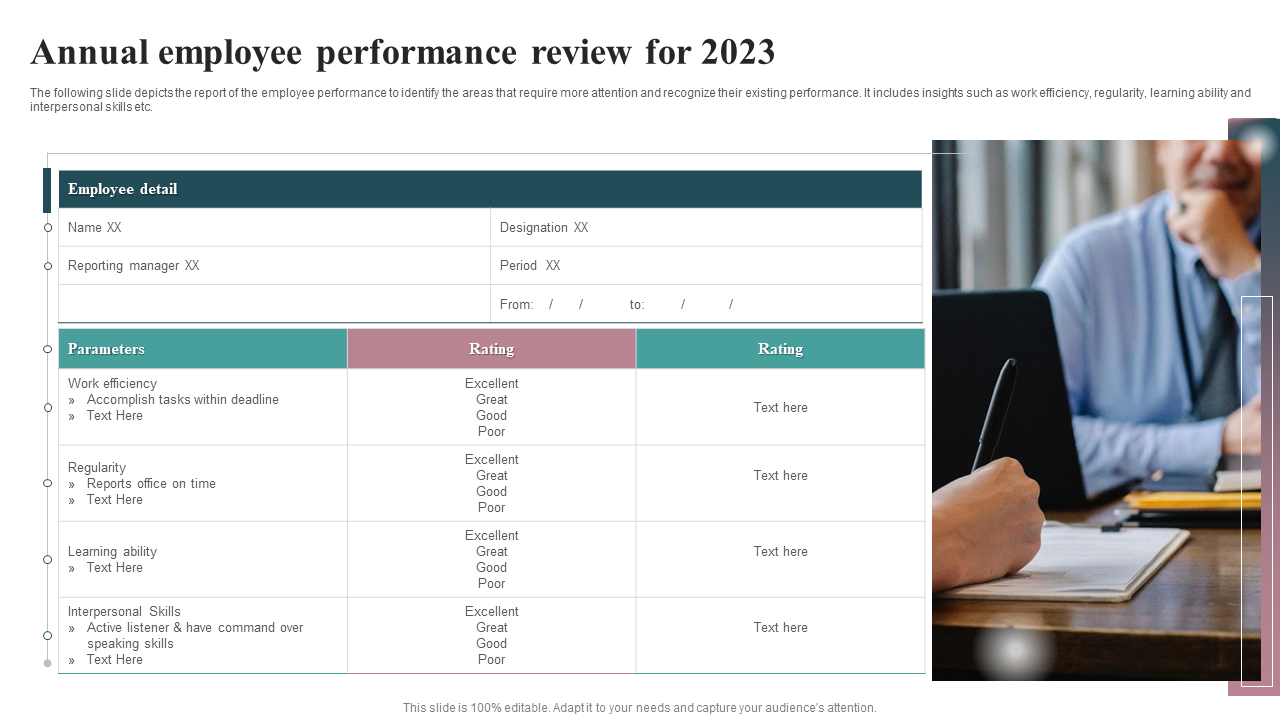










![Top 11 Work Anniversary Templates to Wish Your Peers and Employees [Free PDF Attached]](https://www.slideteam.net/wp/wp-content/uploads/2022/04/Top-11-Work-Anniversary-Templates_1-1013x441.png)
![25+ One-Page Performance Reports for a Result Driven Assessment [Free PDF Attached]](https://www.slideteam.net/wp/wp-content/uploads/2022/03/1013x441no-button-18-1013x441.jpg)











